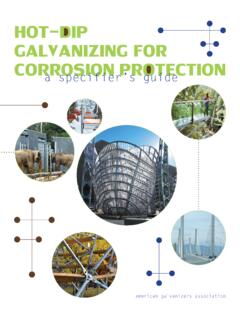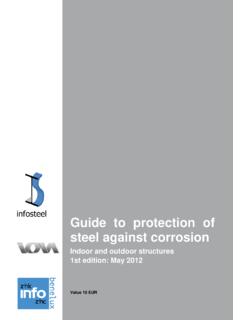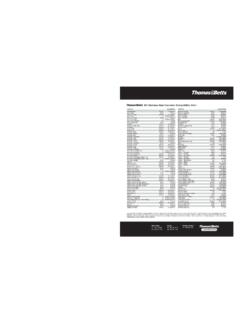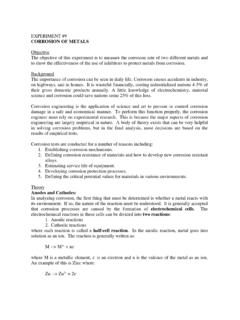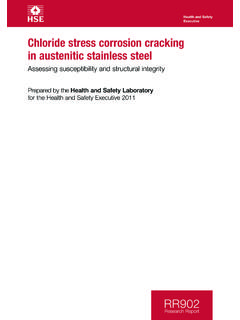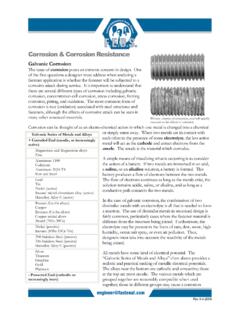Transcription of CHLORIDE-INDUCED PITTING CORROSION OF AUSTENITIC …
1 CHLORIDE-INDUCED PITTING CORROSION OF AUSTENITIC STAINLESS steel D ATE : 08 /2 0/2 018 AUTHORED BY: DR. BRENT EKSTRAND, VICE PRESIDENT, SCIENCE & TECHNOLOGY BACKGROUND: On August 17, 2018 a request was received from an Astro Pak Sales Manager asking me to evaluate some photographs and advise as to potential cause of the surface imperfections observed. PHOTOGRAPHS: 1. 2. PAGE 3 3. INTERPRETATION: The photographs strongly suggest that chloride-inducted PITTING CORROSION is taking place. The observed visible pits, the whitish hazing of the surface, and the white streaks are all consistent with PITTING CORROSION . It is known that the stainless steel has been in contact with a product that contains HCl, further suggesting that the PITTING CORROSION is CHLORIDE-INDUCED .
2 DISCUSSION: Chloride induced PITTING CORROSION is a known issue with AUSTENITIC stainless steel alloys such as 304 and 316. Alloy 316 is somewhat more resistant to the initiation of CHLORIDE-INDUCED PITTING than is alloy 304, but not fully resistant. PITTING CORROSION is a localized form of galvanic CORROSION . It is initiated at a local imperfection in the passive layer, which can be the site of an inclusion, or a stressed area from bending or forming, or damage from impact (among other causes). PITTING CORROSION takes place in neutral or acidic solutions containing chlorides (Cl-). The chloride ion penetrates the imperfection and begins the process of pit initiation. FIGURE 1: The chloride ion creates a localized anode that is surrounded by the large cathode which is the undamaged surface.
3 The rate of the growth of the pit (pit depth) accelerates as the pit progresses, with a time v depth curve that is parabolic. FIGURE 2: FIGURE 3: As chloride in solution enters the pit, it spontaneously forms HCl (hydrochloric acid), which attacks the alloy. Iron atoms are removed via dissolution from the alloy crystalline structure, reacting and forming ferric hydroxide (expressed in chemical shorthand as Fe(OH)3 ). As noted above, the rate of metal loss accelerates as the pit deepens. Factors that influence PITTING rate include Cl- content, pH value, temperature, and the presence of oxidizing agents. This form of CORROSION is often more detrimental than general CORROSION , due to the rapidity of the local PAGE 5 dissolution of the metal, which can cause rapid penetration of the full metal thickness.
4 In many cases PITTING CORROSION is not detected until severe damage occurs, such as complete penetration in sheet or tube material. This is due to the very small pit holes formed on the surface, which can be covered by CORROSION products from a pit attack, effectively creating a lid on top of the pit, with only a very small opening as a result. This creates a situation where fluid exchange is minimal. This can make rinsing ineffective as a method of removing the chloride ions from the pit, especially as the pit deepens. The lack of fluid exchange also means that passivating with the pits uncorrected is ineffective. Pits must be polished away (MP or EP). When examining the metal surface for pits it should therefore be thoroughly cleaned to reveal the pitted areas.
5 PITTING is considered more dangerous than uniform CORROSION damage because it is more difficult to detect, predict and design against. A small, narrow pit with minimal overall metal loss can lead to the failure of an entire engineering system. The rate of penetration may be 10 to 100 times greater than that by general CORROSION . Report Author Dr. Brent Ekstrand, VP of Science & Technology Date 08/20/18 QA Review by Osvaldo Gonzalez, R & D Chemist Date 08/20/18

